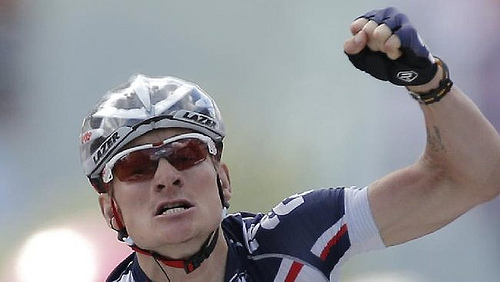
Greipel wins! Take that pedals!
At the finish, Mark Cavendish’s Etixx-Quick Step team made a bollocks of it. Starting his effort early, Cavendish seemed to be sprinting for an age with a great line of riders just chilling out behind him, biding their time. Other than Greipel, Peter Sagan and Fabian Cancellara also went past him. The former will be gutted with second place and the latter will be delighted with third.
Sagan managed seven top five finishes in the first seven stages of last year’s Tour. By the end of the week, he’d finished second four times and not won. The last thing he wanted was another runners-up spot.
For his part, Cancellara did what he pretty much always does, which is find a way to take the yellow jersey in the first week. Greipel gains the green one.
Echelons!
The reason why Cancellara could take the overall lead was because there was a split in the bunch and yellow-clad Rohan Dennis was caught on the wrong side of it. As for how this happened, the answer is crosswinds.
It’s hard to express just how much I love crosswinds and it’s also hard to explain why. I think it’s the surprise element. Tour stages usually follow a fairly predictable pattern and you can identify the danger points months in advance. However, when the wind gets up, the peloton can split at any moment and major contenders can lose surprisingly large amounts of time. It’s all so gloriously chaotic.
It’s also good to see the top riders struggling as also-rans. Being miniature and good uphill is the best way to win a Grand Tour, but to survive a day of echelons, you need straightforward brute force. You need to be fast to stay near the front and you need to battle the wind when you’re not near the front.
When the wind and the rain kicked in on stage two, the split resulted in a front group of 26 riders and not all of the overall contenders were in it. Of the main four, Chris Froome and Alberto Contador were, while Vincenzo Nibali and Nairo Quintana weren’t. Froome also snatched an additional four seconds on Contador after a gap opened up in that front group right at the finish.
Other overall contenders the right side of the divide included Tejay Van Garderen, impressively; Rigoberto Uran, understandably, given he rides for the same crosswind-loving Belgian team as Cavendish; and Warren Barguil, inexplicably.
Pretty much everyone else lost 1m28s to Froome, although a large number of outsiders were in a third group that lost over five minutes. These included website favourite, Laurens Ten Dam and Briton Steve Cummings who waves goodbye to his top ten position, perhaps never to see it again.
Is 1m28s a big gap?
It is actually. In some years, the Tour de France goes an entire week with the entire peloton separated by about seven seconds, but 1m28s is a big gap even by the standards of a mountain stage.
In fact that’s a good way of appreciating it. When they hit the mountains next week, time a minute and a half while they’re climbing and try and judge just how much ground they cover in that time. Now imagine how hard it would be to get that far ahead of Chris Froome and Alberto Contador. Not easy.
Adam Hansen’s down
Today’s update’s spiralling towards War and Peace length, but I have to mention that despite dislocating his shoulder, Adam Hansen’s still in the race. “Was told its going to be the most painful three weeks four me,” he tweeted. “I eat pain for breakfast. Bring it on!”
Breakfast: pain. Lunch: pain. Do you know what Adam Hansen has for dinner?
You’re not wrong. Whichever rider you’re supporting overall, you are also supporting Hansen. This is the 12th consecutive Grand Tour he has entered and he has completed each of the previous 11. Most riders do one or at most two a year. Hansen has been doing three, year after year. If he finishes the Tour, he will equal the all-time record. There’s more I’d like to recount about the Australian rider, but in the interests of brevity, here’s a link instead.
Stage three
Grand Tour contenders train for hour-long efforts. The stage finish up the Mur de Huy will take about five minutes. Easy, you might think, but no, it’s actually much, much harder.
Here’s the profile of the Mur de Huy. The thing to remember is that these guys are racing. There’s no pacing yourself. It’s fastest wins. You’re hitting a 20% slope and you’re racing. It’s a phenomenally hard effort. The overall contenders might be considered the best climbers, but do they have the muscle for this sort of an effort? It’ll be fascinating to find out.
Leave a Reply